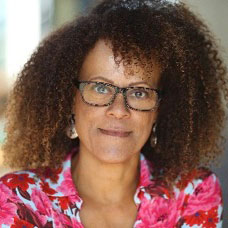
Pitt Rivers Museum, University of Oxford
Accession number:
Bernardine Evaristo
Soon after birth, a ceremony was conducted by a great holy man, who was considered morally and spiritually superior to all the other islanders. He pushed the infant’s head into a bowl of water and if it did not drown, it was admitted to his religious sect, (Exhibit X: a font)
A new-born was assigned a gender based on its biological sex, male or female. There were two official genders, man or woman, until The Gender Revolution of the mid twenty-first century created the first completely agender society. (Exhibit X: a pink frilly dress)
In those times, all females were allowed to give birth to a child, irrespective of aptitude and training. Children lived with and were dependent on what were called parents. They were not considered fully capable until they reached ‘adulthood’. (Exhibit X: a small brain)
Their caste system was accepted as the natural order. At the top were people born with blue blood who were the clever ruling elite and towards the bottom were people born with red blood, who were poor and ignorant. Lowest of all were people called race. (Exhibit X: cave drawing)
Islander children had to read The Books, which were made of trees. Later, when trees became extinct, these were replaced with a metal contraption that could harvest and disseminate all knowledge. In those days, knowledge was a thing. (Exhibit X: a defunct hard drive)
The islander children went through ‘puberty’, the stage prior to adulthood. The girls grew breasts and the boys grew an engorged penis. At this stage they discovered sexual arousal and had to be stopped from random acts of procreation. (Exhibit X: a boy’s penis)
Soon after puberty, islander girls went through what was called ‘menstruation’, where blood was excreted out of their vaginas as a form of purging. The girls were told to never discuss it with anyone else. It was a taboo and females would be outcast for doing so. (Exhibit X: a tampon)
Older girls wore adornments and painted their faces many colours. Some had their bodies surgically altered to meet what was called ‘beauty ideals’. They also sprayed themselves with smells, replicating the scent of animals. (Exhibit X: a small bottle)
The rite of passage for older boys was to spend time locked up inside The Prison, where they learnt how to become a man. They also developed physical prowess through kicking a ball on grass, and warrior skills through killing each other. (Exhibit X: a hunting knife)
Mating was an islander preoccupation involving male human bodies inseminating their seed into female human bodies, attracted by their smells. After a gestation period of wombic growth, a human child climbed out and began to ask questions. (Exhibit X: a bilical chord)
‘Marital’ was where blue blood islanders could officially live in union together and build a homestead. In time this was extended to red blood people who became the happiest in society. Thereafter they were referred to as the gays. (Exhibit X: a gold ring)
Food had to be eaten three times a day. Their diet consisted of animals, birds and fish (before they all died out), vegetables, fruits, grains, canned goods, beans, and fried potato slices in what were called plastic bags, until plastic also became extinct. (Exhibit X: can of tomato soup)
Mind-altering substances were freely available to the islanders who imbibed and ingested liquids and herbs for their hallucinatory effects. Half of them spent every evening in intoxicated states which eventually destroyed their minds and hygiene habits. (Exhibit X: coca leaf)
The islanders engaged in various work functions for what was called money. Those who did the most unsavoury jobs, such as cleaning toilets or other people's bottoms, were the least remunerated. The Great Wage Rebellion failed. (Exhibit X: a coin)
In old age, the islanders were sent away to live in buildings where they had helpers. They stayed in dormitories and made craft objects at Christmas for sale in charity shops. The meaning of craft objects, Christmas, charities and shops is unclear. (Exhibit X: a bed pan)
Most people died before they reached eighty years of age. Although life was known to be finite, death was still feared. There was no specified date or time for dying, but instead the islanders' bodies deteriorated, as they were made of organic matter. (Exhibit X: a wooden death box)
The concept of mourning was a period of bereavement when a loved one died. Love was an extreme version of liking. Liking was a preference for someone or something. Before The Age of Logic, people had feelings which governed their lives. (Exhibit X: an anti-depressant pill)
Evidence of this society was uncovered in recent times when there was an earthquake in the region, and traces of their ancient settlements resurfaced.
Please fill in an evaluation form before you leave and deposit it in the box. Thank you